Bond Watch: how to get an 8% yield
Sam Benstead breaks down the latest news affecting bond investors.
27th June 2025 12:02
by Sam Benstead from interactive investor

Delivering yields at around double the level of UK government bonds (gilts), is the “debt & loans” investment trust sector too good to be true?
There are six investment trusts in this Association of Investment Companies (AIC) sector, with yields averaging out at 8%. They range from 5% at NB Distressed Debt to 8.9% at M&G Credit Income.
- Invest with ii: Invest in Bonds | Share Dealing with ii | Open a Low Cost SIPP
The trusts all follow distinct investment styles, but the common thread is that they can buy company debt that is not publicly tradable, as regular bonds are. This means that they have access to more specialist, but potentially higher-yielding and therefore generally riskier, parts of the debt world.
This includes “floating rate” bonds, where coupons are linked to interest rates, which means that returns rise and fall as interest rates do. This type of debt is really useful when interest rates are rising, as they are more resilient than fixed-interest bonds, which see their value eroded when rates rise.
Company | Assets (£) | 1-yr return (%) | 5-yr return (%) | 10-yr return (%) | Dividend yield (%) |
333.78 | 9.46 | 67.51 | 96.57 | 8.64 | |
245.36 | 16.25 | 87.81 | 110.3 | 7.74 | |
409.35 | 7.97 | 35.68 | 65.49 | 7.08 | |
169.06 | 7.14 | 29.97 | N/A | 8.94 | |
10.97 | -3.23 | -8.4 | -44.89 | 5 | |
246.48 | 12.25 | 51.16 | 84.26 | 8.5 |
Source: AIC/Morningstar, 26 June 2025. Past performance is not a guide to future performance.
The best-performing fund over the past decade is CVC Income & Growth, which has more than doubled investors’ money. It has about 80% invested in floating-rate debt and splits it portfolio roughly half and half between higher-risk “credit opportunities” and more stable “performing credit”.
- Bond Watch: what do steady rates mean for bond investors?
- Benstead on Bonds: how to beat the ‘single biggest’ wealth destroyer
Over 80% of CVC Income & Growth’s portfolio is senior secured loans, thereby offering protection in case companies default. Additionally, the managers argue that default rates are low to begin with. They calculate that in 2022, 2023 and 2024, the loss rate was 0%. 0.35% and 0.10%.
They add: “More impressively, if you look back over 10 years, CVC’s platform has only had a loss given default rate of 5bps or 0.05% - that compares to 0.4% for the wider loan market as a whole, highlighting significant outperformance.”
The trust is rated by analyst Kepler as an Alternative Income idea.
Winterflood, a stockbroker, has noted that in a “higher for longer” interest rate environment, the assets held by CVC Growth & Income are set to sustain income generation at a level that many investors would deem attractive. Moreover, it thinks a degree of floating rate exposure can act as a portfolio hedge.
On the other hand, Winterflood says that Invesco Bond Income Plus, which invests in high-yield bonds and other debt instruments, could do well in a period of interest rate cuts.
“Given that the portfolio has predominantly fixed-rate exposure and relatively high duration, we believe that it is well-positioned to benefit from the market’s base case scenario of interest rate reductions this year,” the analyst said.
The highest yielder, M&G Credit Income, gives investors income without “duration” risk – which is the impact that changing interest rates have on bond prices.
Kepler says: “M&G Credit Income is a highly flexible fixed-income fund which delivers a very high yield without taking the credit risk, duration risk, or gearing that is usually used to achieve this. The yield is achieved from a portfolio of investment-grade quality on average, a duration below one, and no gearing.”
While this investment trust sector can certainly deliver market-beating yields, without necessarily adding too much risk, it’s vital to understand what’s under the bonnet of these funds before investing, as they own complex debt instruments that can behave in different ways to regular bonds.
These articles are provided for information purposes only. Occasionally, an opinion about whether to buy or sell a specific investment may be provided by third parties. The content is not intended to be a personal recommendation to buy or sell any financial instrument or product, or to adopt any investment strategy as it is not provided based on an assessment of your investing knowledge and experience, your financial situation or your investment objectives. The value of your investments, and the income derived from them, may go down as well as up. You may not get back all the money that you invest. The investments referred to in this article may not be suitable for all investors, and if in doubt, an investor should seek advice from a qualified investment adviser.
Full performance can be found on the company or index summary page on the interactive investor website. Simply click on the company's or index name highlighted in the article.